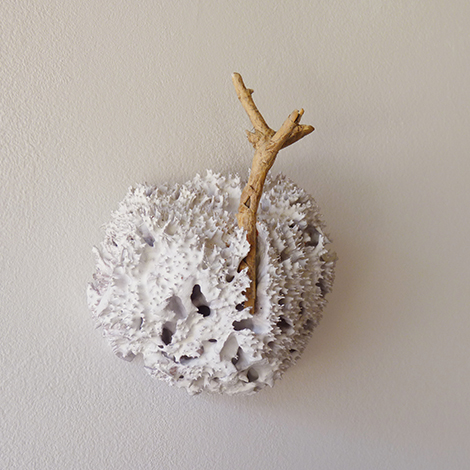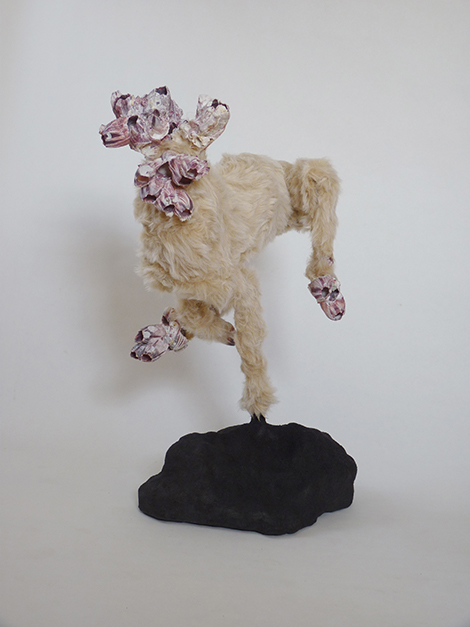Taking the animal kingdom as a point of departure, Japanese-born artist Misako Inaoka explores formal and conceptual concerns, posing broad questions about life on our planet, its evolution and human interventions. As man exerts continual domination over beast, with even the seemingly benign domestication of pets making man the arbiter of animals’ destiny, perhaps the most extreme manifestation of this is the creation of genetically-engineered hybrids. “Fractured Fauna” suggests genetic intervention taken to an absurd extreme, yielding mutant creatures—part H.G. Wells, part Laura Ashley.
The exhibition features arresting sculpture of diverse scale and a variety of works on paper. Inaoka also created Johansson Projects’ now iconic ceiling of green vegetation, actually chemically treated moss, for the gallery’s 2007 inaugural show. The playful feel of this gesture, morphing verdant turf with the architecture of human structures, carries through into Inaoka’s new body of work where domestic artifacts supplant the living flesh of creatures.
Tiny, fragile-appearing works incorporating natural objects such as leaves, sticks and feathers, like Sea Sponge Heart (2014), are displayed on small shelves in groupings, or mounted on the wall. These range from loosely interpreted animals, including Cat Collage (2014), a motion-activated pair making gestures and peeping noises, to more abstracted forms.
Large, freestanding sculptures propose to share the space with us as equals. The Bear (2014) is a dramatic, headless construction of faded green and gold upholstery fabric, also suggesting a deer or even a mountain lion, perched on three spindly wooden furniture legs. It appears caught in the midst of scaling some precipice, its implied climb evincing the feeling of a transitory, vulnerable effort. While this mixture of creature and sofa is initially humorous, a quality of pathos and dysfunction undergirds the work with a more serious tenor. Barnacle (2014) is a particularly disturbing hybrid, part goat, part sea creature; the small furry white critter balances atop one leg on a black mass resembling a rock. Instead of head or hooves, oversized, striated purplish barnacles form jarring outcroppings. One might shudder a bit at the freakish sight, which vaguely evokes two-headed calves and a carnival sideshow vibe.
In the rear of the gallery, miniature human figures, which make their appearance on shelves, their humped and shrouded forms both humorous and frightening, appear as if they are melting or perhaps wearing ill-fitting ghost costumes. A trio of moon-suited Repair Men (2014), with yellow heads, goggles and gloves, bend to approach an unseen object. Man’s role in this universe is ambiguous.
Inaoka’s creatures seem the most powerful when the allusion to actual animals is the strongest, giving the viewer a more visceral reaction as the recognition of some distinct animal phylum meets with the disconnect of disrupted expectation. The diametric opposite of an artist like Damien Hirst, whose arrogance allows him to display dismembered mammals for the sake of spectacle, Inaoka imbues her elegant work with a sensitivity and empathy that resonates throughout.





